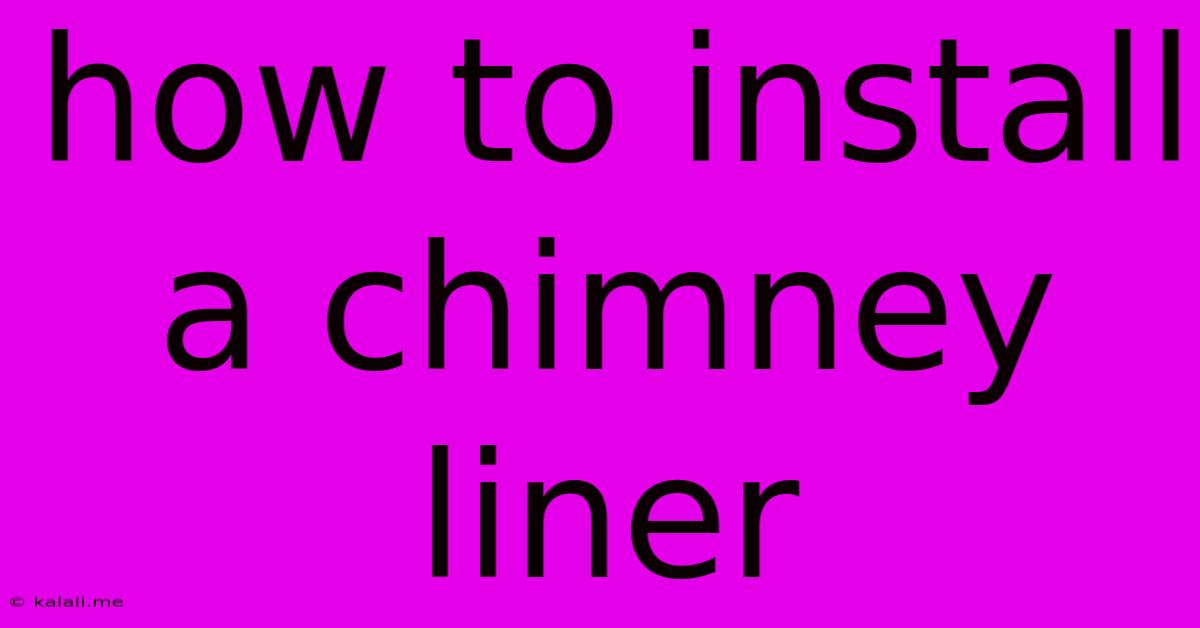How To Install A Chimney Liner
Kalali
Jun 08, 2025 · 3 min read

Table of Contents
How to Install a Chimney Liner: A Comprehensive Guide
Installing a chimney liner is a crucial step in ensuring the safety and efficiency of your fireplace or wood-burning stove. A properly installed liner protects your home from dangerous chimney fires by creating a smooth, fire-resistant pathway for exhaust gases. This comprehensive guide walks you through the process, but remember: this is a complex task best left to professionals unless you have significant experience with chimney work and construction. Improper installation can lead to serious safety hazards.
Why Install a Chimney Liner?
Before diving into the installation process, let's understand why a chimney liner is so important. Older chimneys often lack adequate fire protection, and cracks or deterioration can lead to dangerous situations. A liner provides several key benefits:
- Fire Safety: The primary function is to prevent chimney fires by creating a separate, fire-resistant pathway for hot gases.
- Improved Draft: A smooth liner improves the draft, leading to a more efficient burn and reduced creosote buildup.
- Extended Chimney Lifespan: Protecting the interior of the chimney from corrosive gases extends its overall lifespan.
- Compliance with Building Codes: Many areas require chimney liners for safety and compliance reasons.
Types of Chimney Liners
Several types of chimney liners are available, each with its own advantages and disadvantages:
- Flexible Liners: These are the most common type, made from stainless steel and easily installed in existing chimneys. They're flexible enough to navigate bends and curves.
- Rigid Liners: Made from clay tile or metal, these liners offer superior durability but require more precision during installation. They are often used for larger chimneys or those with complex configurations.
- Insulated Liners: These liners include an insulating layer to further protect the chimney and increase efficiency.
Tools and Materials You'll Need (for a flexible liner installation):
- Flexible liner kit: Choose a liner with the correct diameter and length for your chimney.
- Cleaning brush: To remove existing debris from the chimney.
- Inspection camera: To assess the condition of your chimney before installation.
- Measuring tape: To ensure accurate liner length.
- Safety harness and rope: For working at heights.
- Gloves and safety glasses: To protect yourself from injury.
- Drill with masonry bit: For securing the liner at the top and bottom.
- Appropriate sealant: To create a secure seal around the liner.
Step-by-Step Installation Guide (Flexible Liner):
Disclaimer: This is a simplified guide. Professional assistance is strongly recommended.
- Chimney Inspection: Thoroughly inspect your chimney for cracks, damage, or obstructions. Use a chimney inspection camera to see inside.
- Chimney Cleaning: Clean out all debris, creosote, and obstructions from the chimney flue.
- Measurement: Accurately measure the chimney's height and any bends or curves. Add extra length to account for the top and bottom terminations.
- Liner Insertion: Carefully feed the flexible liner down the chimney, ensuring it's guided smoothly around any bends.
- Secure Top and Bottom: Securely attach the liner at the top and bottom using appropriate fasteners and sealant. Create a watertight seal to prevent water ingress.
- Inspection and Testing: After installation, inspect the liner for any issues and perform a thorough test to ensure proper draft and no leaks.
Important Considerations:
- Proper Ventilation: Ensure adequate ventilation in the room where the fireplace or stove is located.
- Local Codes and Regulations: Check with your local authorities for building codes and permits required for chimney liner installation.
- Professional Help: If you're unsure about any aspect of this process, contact a certified chimney sweep or contractor.
Installing a chimney liner is a critical safety measure. While this guide provides an overview, the complexity of chimney work necessitates professional expertise. Prioritizing safety and proper installation practices will ensure the longevity and safe operation of your fireplace or wood-burning stove for years to come. Don't hesitate to contact a qualified professional for assistance; the cost is far outweighed by the risk of a chimney fire.
Latest Posts
Latest Posts
-
Nec Maximun Breaker For Awg Wire
Jun 09, 2025
-
What Size Pump Do I Need For My Pool
Jun 09, 2025
-
How Well Does Maddox Combustion Leak Detector Work
Jun 09, 2025
-
Can You Tap A Creature With Summoning Sickness
Jun 09, 2025
-
On The Cards Or In The Cards
Jun 09, 2025
Related Post
Thank you for visiting our website which covers about How To Install A Chimney Liner . We hope the information provided has been useful to you. Feel free to contact us if you have any questions or need further assistance. See you next time and don't miss to bookmark.